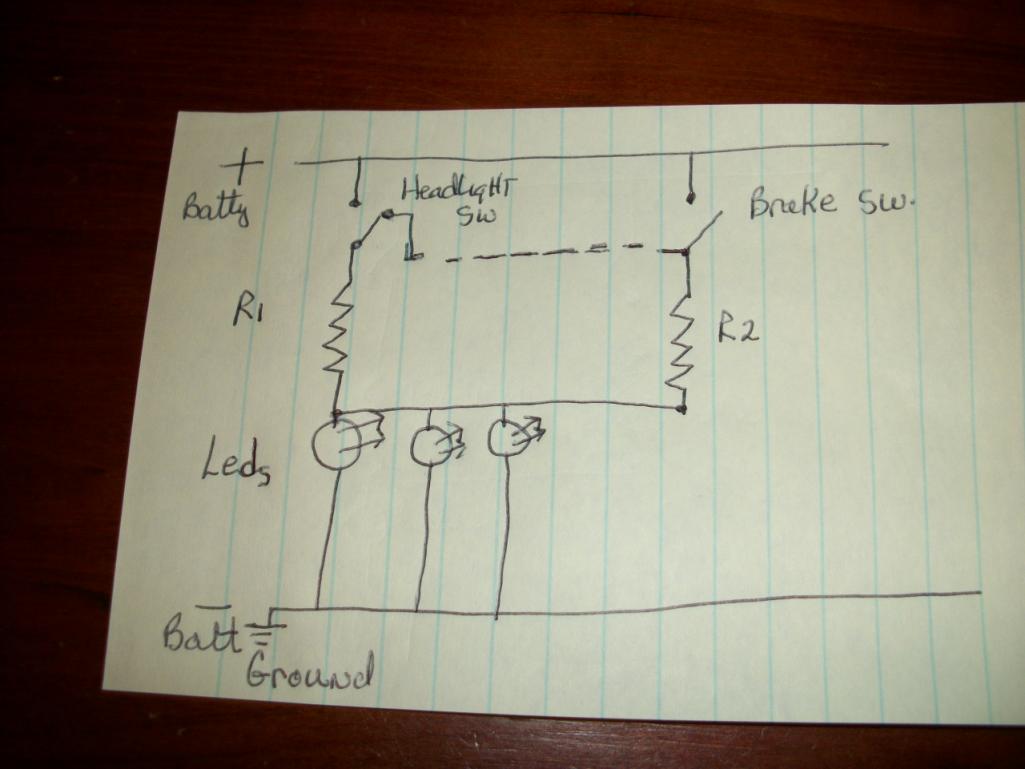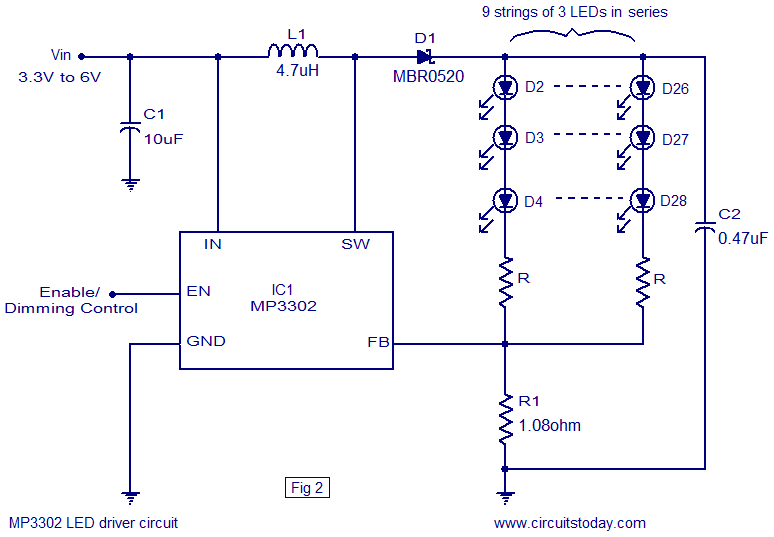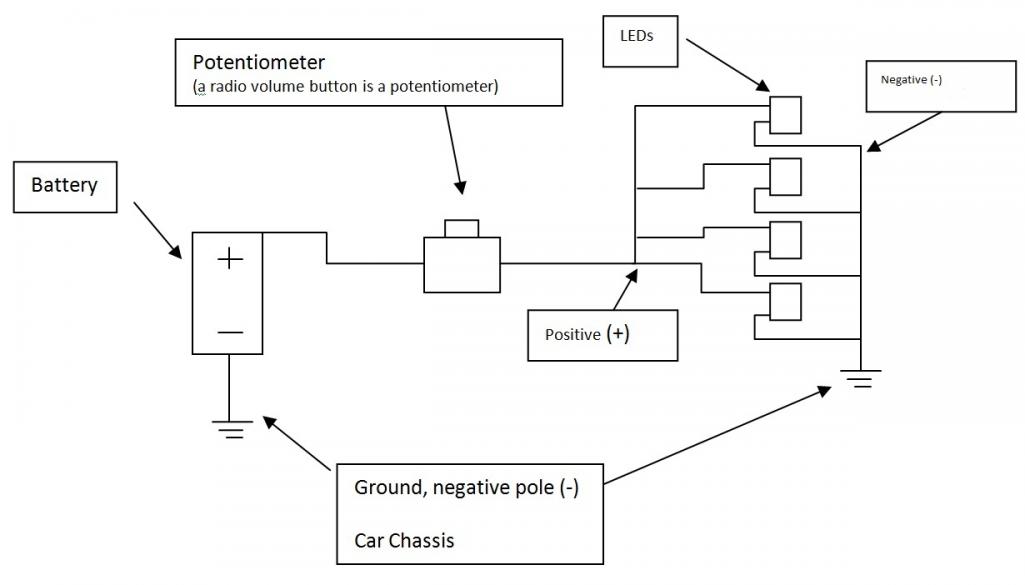|
|

|
Porsche, and the Porsche crest are registered trademarks of Dr. Ing. h.c. F. Porsche AG.
This site is not affiliated with Porsche in any way. Its only purpose is to provide an online forum for car enthusiasts. All other trademarks are property of their respective owners. |
|
|
  |
| dlo914 |
 Nov 30 2012, 12:45 AM Nov 30 2012, 12:45 AM
Post
#1
|
|
Whatchu' lookin' at?!?!     Group: Members Posts: 3,433 Joined: 6-September 04 From: San Gabriel, CA Member No.: 2,697 |
So i've retrofitted some LED rings into my daily driver, but i'm only using the LEDs as the running lights and using the filament bulb when brakes are applied. how would i go about using the LEDs for both running and braking light usage? i know i'm suppose to add a resistor to each positive LED wire, but i'm so confused as to what OHM rating or % etc i'm suppose to use. The guys at two radioshacks were useless.
Here's how they look at the moment: (IMG:http://www.914world.com/bbs2/uploads_offsite/i62.photobucket.com-2697-1354257938.1.jpg) |
| Tom |
 Nov 30 2012, 04:49 AM Nov 30 2012, 04:49 AM
Post
#2
|
|
Advanced Member     Group: Members Posts: 2,139 Joined: 21-August 05 From: Port Orchard, WA 98367 Member No.: 4,626 Region Association: None |
LED brilliance is controlled by current flow. Current flow is adjusted by the resistance in series with the LED. Add more resistance, dim the output of the LED.
Less resistance = brighter until you over power the LED and it burns out. Not surprised by the lack of knowledge at Radio Shack. I will give your problem some thought and draw a circuit for you later today. Tom |
| Tom |
 Nov 30 2012, 05:58 AM Nov 30 2012, 05:58 AM
Post
#3
|
|
Advanced Member     Group: Members Posts: 2,139 Joined: 21-August 05 From: Port Orchard, WA 98367 Member No.: 4,626 Region Association: None |
Are these rings a plug in to the regular socket where the normal bulb went?
If so, You are going to have a hard time getting inside the module to effect a change in brilliance. You should be able to put brake light plug in modules also and they would be engineered for extra brilliance. Tom |
| Spoke |
 Nov 30 2012, 08:26 AM Nov 30 2012, 08:26 AM
Post
#4
|
|
Jerry      Group: Members Posts: 7,185 Joined: 29-October 04 From: Allentown, PA Member No.: 3,031 Region Association: None 
|
For the brake light with higher intensity, as Tom said, use a lower value resistor.
To do this, you'll need to know how the unit is wired. Got a pic and/or model number of the unit? You want to use them as both brake lights and running lights. For the running lights, there are only 2 wires. For running lights and brake lights, you'll need 3 wires like the typical 1057 brake/running bulb. |
| Bartlett 914 |
 Nov 30 2012, 08:33 AM Nov 30 2012, 08:33 AM
Post
#5
|
|
Advanced Member     Group: Members Posts: 2,218 Joined: 30-August 05 From: South Elgin IL Member No.: 4,707 Region Association: Upper MidWest |
I am doubtful that adding resistance will give satisfactory results. You need to pulse the lamp. By varying the duty cycle, you will dim the LED
|
| Nine_14 |
 Nov 30 2012, 09:12 AM Nov 30 2012, 09:12 AM
Post
#6
|
|
Member   Group: Members Posts: 311 Joined: 30-August 12 From: Germany Member No.: 14,873 Region Association: Germany |
|
| Tom |
 Nov 30 2012, 02:24 PM Nov 30 2012, 02:24 PM
Post
#7
|
|
Advanced Member     Group: Members Posts: 2,139 Joined: 21-August 05 From: Port Orchard, WA 98367 Member No.: 4,626 Region Association: None |
Here is a simple led circuit than will allow the running light LED's to be one brilliance and the brake lights to be a higher brilliance. Your ring LED's will be hard to modify to do this.
Say each LED was a .2 watt. With (it looks like over a hundred LED's) that would require a 25 watt or bigger resistor. ( current thru one section of the circuit is constant thru the whole circuit.) Resistors this size will not be cheap. Smaller ones for pennys. Also if this is a plug in module, it will be difficult to modify to have the brake light circuit in parallel as in the simple drawing. You would also have to have terminals on the headlight switch to allow rewiring to make the brake light circuit the same brilliance reguardless if the headlights are on or not. Here is how the circuit works: When headlights(running lights) are on, the path is from batt + to closed contacts of the headlight switch, thru R1, to LED's to ground. If brakes are applied, you will have a parallel circuit with R2 also connected to the LED's. Resistors in parallel are less ohmic value than either resistor. Hense the brake lights and running lights would get brighter. With no headlights on, ( the doted line is hooked up) the path is a parallel one from batt + thru brake light switch to headlight switch thru parallel resistors to LED's to ground. The headlight running light LED's and brake light LED's would operate. hope this has shed some light ( no pun intended) on your delima. I don't know how auto lights are dimmed using LED's, but I suspect it is a cycle of on/off pulses to the LED's as they are very fast in operation. Say running lights get a pulse rate of 60 and brake lights. seperately wired, would have a pulse rate of 100. Brake lights would be brighter. Tom Attached thumbnail(s) 
|
| mr914 |
 Nov 30 2012, 03:04 PM Nov 30 2012, 03:04 PM
Post
#8
|
|
914 Hillbilly    Group: Members Posts: 576 Joined: 11-January 03 From: Lincoln NE Member No.: 131 Region Association: None |
Temporary, or could be permanent...
Buy a variable resistor/potentiometer Put in circuit and adjust to desired brightness Remove and measure with ohm meter. Go to rat shack and buy resistor of appropriate value |
| Dave_Darling |
 Nov 30 2012, 05:23 PM Nov 30 2012, 05:23 PM
Post
#9
|
|
914 Idiot                Group: Members Posts: 15,196 Joined: 9-January 03 From: Silicon Valley / Kailua-Kona Member No.: 121 Region Association: Northern California 
|
All the automotive LED taillights I know of blink. Drives my wife up the wall, because she can see them flicker. (Better eyesight, or maybe just less persistence of vision than many of us.) Vertical bar lights, especially Cadillacs, are the worst. But they all do blink.
If it were as simple as putting a resistor in line with the LEDs, I think they probably would do it. So there is likely a reason they use the blinking circuitry instead. Perhaps the LEDs last longer that way? --DD |
| Spoke |
 Nov 30 2012, 05:52 PM Nov 30 2012, 05:52 PM
Post
#10
|
|
Jerry      Group: Members Posts: 7,185 Joined: 29-October 04 From: Allentown, PA Member No.: 3,031 Region Association: None 
|
If it were as simple as putting a resistor in line with the LEDs, I think they probably would do it. So there is likely a reason they use the blinking circuitry instead. Perhaps the LEDs last longer that way? --DD The resistor - LED current limiter is the simplest solution and the least efficient as far as power/energy is concerned. The resistor drops voltage and dissipates significant power and heat. There are a myriad of LED drivers on the market that use a high frequency switching method to efficiently drive the LED. The efficiency can reach 95%. That is 95% of the power is dissipated in the LED. For the resistor current limiter, it is possible that less than 30% of the power is dissipated in the LED and 70% in the resistors. The downside of the switching current limiter is complexity and cost. You need an integrated circuit switching converter, inductor, several capacitors, a schottky diode, and some resistors. |
| Spoke |
 Nov 30 2012, 06:07 PM Nov 30 2012, 06:07 PM
Post
#11
|
|
Jerry      Group: Members Posts: 7,185 Joined: 29-October 04 From: Allentown, PA Member No.: 3,031 Region Association: None 
|
Here's a switching converter to efficiently drive an entire bank of LEDs. This circuit shows an input voltage of 3 to 6V but the same architecture can be used with 12V in.
To dim the LEDs, provide a lower voltage at the EN input. This is easily done with resistors. This particular converter doesn't accept different level input voltage to dim the LEDs but other chips do. Attached image(s) 
|
| stugray |
 Nov 30 2012, 07:34 PM Nov 30 2012, 07:34 PM
Post
#12
|
|
Advanced Member     Group: Members Posts: 3,825 Joined: 17-September 09 From: Longmont, CO Member No.: 10,819 Region Association: None |
There are off the shelf drivers that can do this.
Google 'buckpuck'. If I knew the max current when on full, I could suggest a converter that takes 12VDC and regulates LEDs. Stu |
| Spoke |
 Nov 30 2012, 07:51 PM Nov 30 2012, 07:51 PM
Post
#13
|
|
Jerry      Group: Members Posts: 7,185 Joined: 29-October 04 From: Allentown, PA Member No.: 3,031 Region Association: None 
|
There are off the shelf drivers that can do this. Google 'buckpuck'. If I knew the max current when on full, I could suggest a converter that takes 12VDC and regulates LEDs. Stu I am familiar with the Buckpuck. The Buckpuck is a great product line manufactured in the USA by a small company called LEDdynamics in Vermont. The switching IC in the Buckpuck product line is MP2483 from MPS out of San Jose, CA. I worked for them at the time and the Buckpuck was one of my design wins. |
| 914pipe |
 Nov 30 2012, 08:42 PM Nov 30 2012, 08:42 PM
Post
#14
|
|
Say......TEEEEEEEN!!!!!   Group: Members Posts: 346 Joined: 31-July 04 From: Puerto Rico, now NC Member No.: 2,422 Region Association: South East States |
So i've retrofitted some LED rings into my daily driver, but i'm only using the LEDs as the running lights and using the filament bulb when brakes are applied. how would i go about using the LEDs for both running and braking light usage? i know i'm suppose to add a resistor to each positive LED wire, but i'm so confused as to what OHM rating or % etc i'm suppose to use. The guys at two radioshacks were useless. Here's how they look at the moment: (IMG:http://www.914world.com/bbs2/uploads_offsite/i62.photobucket.com-2697-1354257938.1.jpg) You could use a potentiometer (a volume button from an old radio, analog to be spesific, is a potentiometer) since the potentiometer is just a variable resistor. When you find your desire light intensity you can use a multimeter to find the resistance (ohms) on the potentiometer . After that you can buy a resistor that would be near the ohms you need or you just can leave the potentiometer fixed. Is as simple as positive wire to one end of the potentiometer and the other end will distribute the power to the leds positive side (since this is for the non brake light). Here is a simple diagram without engineering or electrician symbols excepts for the ground symbol (electrical engineer typing). Hope this help. Attached thumbnail(s) 
|
| aircooledtechguy |
 Dec 1 2012, 12:09 AM Dec 1 2012, 12:09 AM
Post
#15
|
|
The Aircooledtech Guy    Group: Members Posts: 1,966 Joined: 8-November 08 From: Anacortes, WA Member No.: 9,730 Region Association: Pacific Northwest |
I'm probably missing something here, but if you are trying to simply use LEDs for the brakes, replace your incandescent bulbs to LEDs and drive away happy. They can be had in any brightness and intensity you want at www.superbrightleds.com
|
| falconfp2001 |
 Dec 1 2012, 02:58 AM Dec 1 2012, 02:58 AM
Post
#16
|
|
Pancho Pantera   Group: Members Posts: 451 Joined: 5-December 10 From: Downey, CA Member No.: 12,456 Region Association: Southwest Region |
I would say you need to check this site out
http://www.superbrightleds.com/cat/flashers-load-resistors/ |
| bperry |
 Dec 1 2012, 12:29 PM Dec 1 2012, 12:29 PM
Post
#17
|
|
Lurker   Group: Members Posts: 477 Joined: 16-February 04 From: Dallas, Tx Member No.: 1,661 |
Here is a link to a DIY article on how to wire up LEDs for DRL and turn signals that
uses resistors for brightness control. Rear Running Lights Mod It is a fancier version of the circuit that Tom drew up. --- bill |
  |
1 User(s) are reading this topic (1 Guests and 0 Anonymous Users)
0 Members:

|
Lo-Fi Version | Time is now: 8th July 2025 - 10:51 AM |
Invision Power Board
v9.1.4 © 2025 IPS, Inc.








